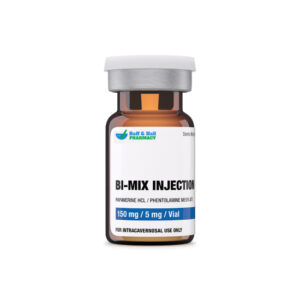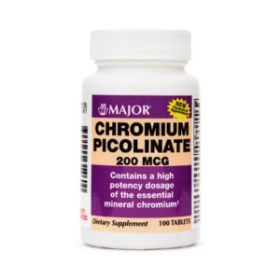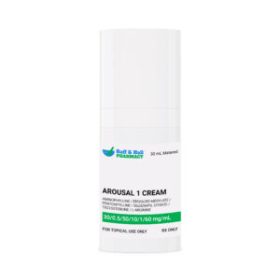Bi-Mix Injection (Papaverine HCl / Phentolamine Mesylate) (Lyo) (Reconstituted – 30 mg / 1 mg / mL)
Super Bi-Mix Injection (Papaverine HCl / Phentolamine Mesylate) (Lyo) (Reconstituted – 30 mg / 2 mg / mL)
To aid penile smoothmuscle, BiMix Injection is a compounded intracavernosal mixture of phentolamine mesylate, a nonselective αadrenergic antagonist, and papaverine hydrochloride, a peripheral vasodilator. Treatment of erectile dysfunction in appropriately selected adult men involves relaxation and quick arterial flow. Customization of concentration and excipients under section 503A lets doctors match pharmacodynamic requirements to individual vascular response while still staying within a patient-specific prescribing framework.
BiMix lacks any prostanoid unlike branded alprostadil monotherapy, hence its clinical profile may benefit patients who suffer from prostaglandin-related penile burning or fibrosis. Through phosphodiesterase inhibition, papaverine raises intracellular cyclic adenosine monophosphate (cAMP); phentolamine provides competitive blockade of cavernous αreceptors, thereby preventing sympathetically driven vasoconstriction. Provided cavernous venoocclusion is present, they may reach erections in around 515 minutes and typically retain stiffness for up to one hour.
Two concentrations of lyophilized powder comprise the preparation. After reconstituting (150 mg / 5 mg per vial), standard BiMix yields 30 mg papaverine / 1 mg phentolamine per mL. Super BiMix provides 30 150 mg / 10 mg per vial, or mg / 2 mL. Under pharmacist supervision, concentrations can be diluted further with bacteriostatic saline to customize titration plans.
Nonselective inhibition of phosphodiesterase isoenzymes resulting in cAMP accumulation, and to a lesser extent, cyclic guanosine monophosphate (cGMP), account mostly for the spasmolytic effect of papaverine. In corporal trabeculae, both second messengers reduce intracellular calcium and uncouple actinmyosin crossbridging.
By competitively blocking postjunctional α₁receptors and presynaptic α₂receptors, phentolamine helps to complement this pathway hence reducing tonic sympathetic outflow and encouraging unoposed parasympathetic vasodilation; coronary and peripheral Data show noticeable decreases in vascular resistance without causing noteworthy venoconstriction.
Papaverine’s cyclic nucleotide surge raises the effect of αblockade when given concurrently, therefore generating a synergistic rise in corporeal arterial flow and sinusoidal expansion; clinical crossover. Research show better rigidity scores and less venous blood escape with either medicine by itself.
Historical studies of intracavernosal injection treatments follow the crucial role papaverine/phentolamine mixtures in changing erectile dysfunction therapy from hard vacuum devices toward pharmacologic autoinjection, sharply increasing the spontaneity of sexual activity in multicenter cohorts.
Current compounding practice uses pharmacopeial data to demonstrate steady dissolution kinetics and expected onset within 10 minutes at restored concentrations between 15 mg / 0.5 mg. While phentolamine’s hemodynamic effect fades within 30–90 minutes, the average halflife of papaverine in plasma remains about two hours at 30 mg / 2 mg mL⁻¹; mL⁻¹;
Patients with hypersensitivity to either component or those with active myocardial ischemia, ventricular arrhythmias, or poorly controlled should not be prescribed BiMix Injection. Hypertension is caused by the potential of papaverine’s vasodilatory burden to either set off reflex tachycardia or worsen cardiac oxygen demand.
Because of its possible provocation of histamine release and gastrointestinal hyperemia, phentolamine is contraindicated in recent myocardial infarction, coronary insufficiency, or signs of peptic ulcer disease; Exaggerated hypotensive reactions seen in postinfarction patients might undermine coronary perfusion.
Ischemic priapism, protracted erection beyond four hours, which, if left untreated, risks corporal fibrosis and permanent impotence, is the most severe regional problem; men under forty, those with High baseline peak systolic velocities and those getting first test doses over 60 mg papaverine have the highest incidence rates.
Clinicians should also abstain from usage in patients with anatomical penile anomalies including Peyronie’s disease or significant cavernous fibrosis, when intracavernosal pressure gradients are erratic. and the risk of tissue damage is increased; worldwide agreement declarations advise different approaches in such groups.
From the single actives, product-specific interaction data are deduced. Since combined papaverine already lowers peripheral resistance, coadministration of antihypertensives—especially nitrates or calciumchannel blockers—can worsen systemic hypotension; staggered dosage is recommended to preserve hemodynamic stability.
Phentolamine greatly increases the vasodilatory effects of phosphodiesterase5 inhibitors (sildenafil, tadalafil, vardenafil), therefore increasing the chance of syncope. Combined usage calls for careful microdosing and monitoring for additive priapism risk.
Clinical studies using adjunctive aviptadil have proven that layered vasodilators improve erectile response but also raise the incidence of postinjection vertigo and flushing, therefore emphasizing the requirement. for formal titration methods when new vasoactive peptides are introduced into an existing BiMix regimen.
Chronic alcohol consumption or anticonvulsants cause hepatic microsomal induction, therefore increasing papaverine metabolism and lowering efficacy; rodent models show upregulation of glutathioneStransferase and enhanced elimination following repeated highdose exposure suggests
Common systemic effects include lightheadedness, mild hypotension, gastrointestinal pain, and transient facial flushing. Usually solving in minutes as plasma levels drop, these events seldom call for drug cessation.
Serious negative consequences include unrelenting erections, muscular pain, and, rarely, high-flow priapism.
Inadvertent intracavernosal venous access has been associated to systemic dizziness or presyncope, therefore causing quick systemic distribution; males with venoocclusive dysfunction need lower starting doses. and obligatory officebased observation starting phase.
Although there is no clinical justification for use in pregnant people, data from a 254,000 pregnancy registry on accidental exposure showed no major link between firsttrimester papaverine consumption. Though statistical confidence is hampered by poor exposure incidence, maternal biliary spasm and major congenital abnormalities can be treated.
Although animal reproduction studies are insufficient, labeling information classifies papaverine solutions as Pregnancy Category C given embryofetal toxicity seen at supratherapeutic doses in rodents, It also recommends a full riskbenefit analysis prior to systematic usage in women of childbearing capability.
Store dry powder at 68°F to 77°F (20°C to 25°C) and away from heat, moisture and light. Once reconstituted keep this medicine in a refrigerator between 36°F to 46°F (2°C to 8°C). Keep all medicine out of the reach of children. Throw away any unused medicine after the beyond use date. Do not flush unused medications or pour down a sink or drain.
- Montague DK, Jarow JP, Broderick GA, et al. Chapter 1: The management of erectile dysfunction: an AUA update. J Urol 2005;174:230-9.
- Leungwattanakij S, Flynn V, Hellstrom WJG. Intracavernosal injection and intraurethral therapy for erectile dysfunction. Urol Clin North Am 2001;28:343-354.
- Andersson, K.E., Pharmacology of penile erection. Pharmacol Rev, 2001. 53(3): p. 417-50.
- Virag, R., et al., Vasoactive intestinal polypeptide release during penile erection in man. Lancet, 1982. 2(8308): p. 1166.
- K.E., A., Pharmacology of erection: agents which initiate and terminate erection. Sex Disabil 1994. 12: p. 53–79.
- Kirkeby, H.J., et al., [Infusion cavernosography and erectile dysfunction]. Ugeskr Laeger, 1990. 152(24): p. 1724-6.
- Juenemann, K.P., et al., Hemodynamics of papaverine- and phentolamine-induced penile erection. J Urol, 1986. 136(1): p. 158-61.
- Delcour, C., et al., The effect of papaverine on arterial and venous hemodynamics of erection. J Urol, 1987. 138(1): p. 187-9.
- Mooradian, A.D., et al., Biweekly intracavernous administration of papaverine for erectile dysfunction. West J Med, 1989. 151(5): p. 515-7.
- Dinsmore, W.W., Medical treatment of impotence with papaverine and phentolamine intracavernosal injection. Ulster Med J, 1990. 59(2): p. 174-6.
- Keogh, E.J., et al., Treatment of impotence by intrapenile injections of papaverine and phenoxybenzamine: a double blind, controlled trial. Aust N Z J Med, 1989. 19(2): p. 108-12.
- Viswaroop, B., A. B, and G. Gopalakrishnan, Evaluating erectile dysfunction: oral sildenafil versus intracavernosal injection of papaverine. Natl Med J India, 2005. 18(6): p. 299-301.
- Traish, A.M., et al., Expression of functional alpha2-adrenergic receptor subtypes in human corpus cavernosum and in cultured trabecular smooth muscle cells. Recept Signal Transduct, 1997. 7(1): p. 55-67.
- Traish, A., et al., Phentolamine mesylate relaxes penile corpus cavernosum tissue by adrenergic and non-adrenergic mechanisms. Int J Impot Res, 1998. 10(4): p. 215-23.
- Wespes, E., C. Rondeux, and C.C. Schulman, Effect of phentolamine on venous return in human erection. Br J Urol, 1989. 63(1): p. 95-7.
- P.R., I., G. B., and B.L. . Human pharmacology of orally administered phentolamine, in Phentolamine in Heart Failure and Other Cardiac Disorders., in Proceedings of an International Workshop London, November 1975 T. S.H. and G. L.A., Editors. 1975, Hans Huber Publishers: Bern, Switzerland.
- O, H., W. U, and K. U, Systemic pharmacokinetics of papaverine and phentolamine: comparison of intravenous and intracavernous application. Int J Impot Res, 1990. 2 (Suppl 2): p. 247–248.
- Eardley, I., et al., Pharmacotherapy for erectile dysfunction. J Sex Med, 2010. 7(1 Pt 2): p. 524-40.
- Dinsmore, W.W. and M.G. Wyllie, Vasoactive intestinal polypeptide/phentolamine for intracavernosal injection in erectile dysfunction. BJU Int, 2008. 102(8): p. 933-7.





